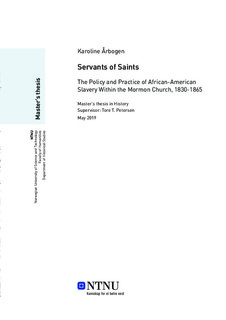| dc.description.abstract | En vanlig oppfatning av mormoner kirken har vært at den var imot slaveri som institusjon i USA. En årsak til denne oppfatning står som konsekvens til profeten Joseph Smith sin anti-slaveri posisjon tatt i sin presidentkampanje i 1844, like før sin død. Selv om denne anti-slaveri posisjonen kom til å være bli samtidsoppfatningen av mormonere, var det langt fra sannheten. Bare tre år etter Smiths død, brakte sørstalige konvertitter av kirken med seg slaver til Utah territoriet, og i 1852 legaliserte en ny territoriell regjering institusjonen med “An Act in Relation to Service”. Denne nyutnevnte territorielle regjeringen var et resultat av kompromisset i 1850, som ga Utah territorial status i USA, samt folkesuverenitet. Ved å holde den allerede pågående praksisen av slaveri i Utah skjult for andre medlemmer av den trettiførste Kongressen i 1850, klarte Utahs representant i Washington, John M. Bernhisel, å forsinke en seksjonskrise i USA, og en borgerkrig ble forskyvet med flere år. Hadde menn i Washington kjent til den allerede eksisterende praksisen av slaveri i Utah i under den trettiførste Kongressen, ville historien ha sett radikalt annerledes ut.
Formålet med denne masteroppgaven er å presentere et studie av en neglisjert del av både kirkens og Utahs historie; politikken og praksisen av afro-amerikansk slaveri innenfor mormoner kirken. Som det vil bli presentert i denne masteroppgaven, ble beslutningen om å legalisere slaveri som institusjon i Utah territoriet påvirket av en rekke samfunnsmessige, kulturelle og religiøse faktorer. Til tross for at mange årsaker spilte inn på avgjørelsen, er det to av dem utpreget skiller seg ut som primære bidragsytere: kirkeprofetenes bibelske begrunnelser for slaveri som institusjon i USA, og den økende rasismen innenfor mormoner kirken etter Joseph Smiths død i 1844.
Denne oppgaven er en analyse av politikken og praksisen av afro-amerikansk slaveri innenfor mormoner kirken fra dens etablering i 1830, til gjennomføringen av frigjøringserklæringen i 1863, som førte til slaveriets slutt i USA. Oppgaven fyller et lakuna i den allerede eksisterende litteraturen innenfor mormoner historie, ettersom forskere i feltet har unnlatt å forske på dette forsømte temaet i historien, som igjen har etterlatt ett hull i moderne historiske arkiver. Formålet med denne masteroppgaven vil derfor være å skape et mer nyansert bilde av mormoner historie og deres religion ved hjelp av rase og slaveri som institusjon, da dette er viktig fremover i studiet av mormoner kirken.
A common perception of the Mormon Church has been that it opposed slavery as an institution in the United States. A reason for this frequent perception is a consequence of prophet Joseph Smith’s anti-slavery position taken in his presidential campaign in 1844, just before his death. While this anti-slavery position came to be the contemporary perception of Mormons, it was far from the truth. Only three years after Smith’s death, Southern Mormon converts brought slaves to the Utah Territory, and in 1852 a new territorial government legalized the institution with “An Act in Relation to Service”. This newly appointed territorial government was a result of the Compromise of 1850, giving Utah territorial status in the United States, as well as granting the territory popular sovereignty. By keeping the already ongoing practice of slavery in Utah hidden from other members of the Thirty-First Congress in 1850, Mormons, and more specifically Utah’s representative in Washington, John M. Bernhisel, was able to delay the sectional crisis in the United States, and a civil war was detained for a few more years. Had the men in Washington known about the already existing practice of slavery in Utah during the Thirty-First Congress, the course of history would have been radically different.
The objective of this thesis is to present a study of a much neglected part of both Mormon and Utah history: the policy and practice of African-American slavery within the Mormon Church. As will be presented in this thesis, the decision to legalize the institution of slavery in the Utah Territory was influenced by a multitude of societal, cultural, and religious factors. Despite many factors playing in on the decision, two of them eminently stands out as primary contributors: the church prophets’ biblical justifications of slavery as an institution in the United States, and the increasing racism within the Mormon church after Joseph Smith’s death in 1844.
This thesis is an analysis of the policies and practices of African-American slavery within the Mormon Church from its establishment in 1830, to the implementation of the Emancipation Proclamation in 1863, leading to slavery’s end in the United States. The thesis fills a lacuna in the existing literature on Mormon history, as scholars in the field have failed to tell the story of this neglected subject in history, largely excluding it from modern historical records. It will therefore be the task of this thesis to create a more nuanced picture of Mormon history and their religion using race and the institution of slavery, as this is paramount moving forward in the study of the Mormon Church. | nb_NO |
